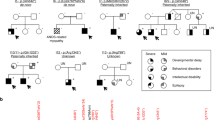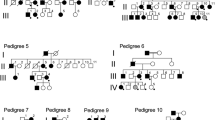Abstract
The main familial focal epilepsies are autosomal dominant nocturnal frontal lobe epilepsy, familial temporal lobe epilepsy and familial focal epilepsy with variable foci. A frameshift mutation in the DEPDC5 gene (encoding DEP domain–containing protein 5) was identified in a family with focal epilepsy with variable foci by linkage analysis and exome sequencing. Subsequent pyrosequencing of DEPDC5 in a cohort of 15 additional families with focal epilepsies identified 4 nonsense mutations and 1 missense mutation. Our findings provided evidence of frequent (37%) loss-of-function mutations in DEPDC5 associated with a broad spectrum of focal epilepsies. The implication of a DEP (Dishevelled, Egl-10 and Pleckstrin) domain–containing protein that may be involved in membrane trafficking and/or G protein signaling opens new avenues for research.
This is a preview of subscription content, access via your institution
Access options
Subscribe to this journal
Receive 12 print issues and online access
$209.00 per year
only $17.42 per issue
Buy this article
- Purchase on Springer Link
- Instant access to full article PDF
Prices may be subject to local taxes which are calculated during checkout


Similar content being viewed by others
Accession codes
References
Scheffer, I.E. et al. Autosomal dominant nocturnal frontal lobe epilepsy. A distinctive clinical disorder. Brain 118, 61–73 (1995).
Berkovic, S.F. et al. Familial temporal lobe epilepsy: a common disorder identified in twins. Ann. Neurol. 40, 227–235 (1996).
Ottman, R. et al. Localization of a gene for partial epilepsy to chromosome 10q. Nat. Genet. 10, 56–60 (1995).
Klein, K.M. et al. Familial focal epilepsy with variable foci mapped to chromosome 22q12: expansion of the phenotypic spectrum. Epilepsia 53, e151–e155 (2012).
Baulac, S. & Baulac, M. Advances on the genetics of mendelian idiopathic epilepsies. Clin. Lab. Med. 30, 911–929 (2010).
Heron, S.E. et al. Missense mutations in the sodium-gated potassium channel gene KCNT1 cause severe autosomal dominant nocturnal frontal lobe epilepsy. Nat. Genet. 44, 1188–1190 (2012).
Kalachikov, S. et al. Mutations in LGI1 cause autosomal-dominant partial epilepsy with auditory features. Nat. Genet. 30, 335–341 (2002).
Berkovic, S.F. et al. Familial partial epilepsy with variable foci: clinical features and linkage to chromosome 22q12. Epilepsia 45, 1054–1060 (2004).
Callenbach, P.M. et al. Familial partial epilepsy with variable foci in a Dutch family: clinical characteristics and confirmation of linkage to chromosome 22q. Epilepsia 44, 1298–1305 (2003).
Morales-Corraliza, J. et al. Familial partial epilepsy with variable foci: a new family with suggestion of linkage to chromosome 22q12. Epilepsia 51, 1910–1914 (2010).
Xiong, L. et al. Mapping of a gene determining familial partial epilepsy with variable foci to chromosome 22q11-q12. Am. J. Hum. Genet. 65, 1698–1710 (1999).
Picard, F. et al. Dominant partial epilepsies. A clinical, electrophysiological and genetic study of 19 European families. Brain 123, 1247–1262 (2000).
Thomas, P., Picard, F., Hirsch, E., Chatel, M. & Marescaux, C. Autosomal dominant nocturnal frontal lobe epilepsy. Rev. Neurol. (Paris) 154, 228–235 (1998).
Scheffer, I.E. et al. Familial partial epilepsy with variable foci: a new partial epilepsy syndrome with suggestion of linkage to chromosome 2. Ann. Neurol. 44, 890–899 (1998).
Ishikawa, K. et al. Prediction of the coding sequences of unidentified human genes. X. The complete sequences of 100 new cDNA clones from brain which can code for large proteins in vitro. DNA Res. 5, 169–176 (1998).
Dokudovskaya, S. et al. A conserved coatomer-related complex containing Sec13 and Seh1 dynamically associates with the vacuole in Saccharomyces cerevisiae. Mol. Cell Proteomics 10, M110 006478 (2011).
Seng, T.J. et al. Complex chromosome 22 rearrangements in astrocytic tumors identified using microsatellite and chromosome 22 tile path array analysis. Genes Chromosom. Cancer 43, 181–193 (2005).
Miki, D. et al. Variation in the DEPDC5 locus is associated with progression to hepatocellular carcinoma in chronic hepatitis C virus carriers. Nat. Genet. 43, 797–800 (2011).
Acknowledgements
We thank the genotyping and sequencing platform of ICM for technical assistance, the DNA and cell bank of ICM for DNA extraction and cell culture, P. Couarch for technical assistance, M. Gaussen for linkage analysis and C. Depienne for helpful discussions. S.I. received a grant from the French government. This study was supported by the program Investissements d'Avenir ANR-10-IAIHU-06.
Author information
Authors and Affiliations
Contributions
S.I. performed experiments and analyzed data. F.P. performed phenotyping and collected clinical data. G.R. collected samples and extracted DNA. E.N. and E.M. participated in genetic experiments. G.A. carried out the bioinformatics analysis on DEPDC5 and statistical analysis. P.T., P.G., M.W., C.M. and E.H. performed phenotyping of families. R.M. and M.B. contributed to the writing of the manuscript. E.L. supervised the project and contributed to the writing of the manuscript. S.B. designed the study, supervised data analysis and wrote the manuscript.
Corresponding author
Ethics declarations
Competing interests
The authors declare no competing financial interests.
Supplementary information
Supplementary Text and Figures
Supplementary Figures 1–4 and Supplementary Table 1 (PDF 1271 kb)
Rights and permissions
About this article
Cite this article
Ishida, S., Picard, F., Rudolf, G. et al. Mutations of DEPDC5 cause autosomal dominant focal epilepsies. Nat Genet 45, 552–555 (2013). https://doi.org/10.1038/ng.2601
Received:
Accepted:
Published:
Issue Date:
DOI: https://doi.org/10.1038/ng.2601



